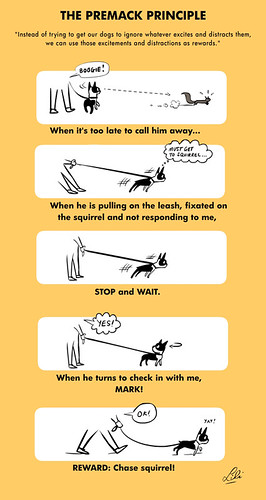Leash Walking
In this class, we systematically cover the many concepts that a dog-and-owner team must learn in order to master the relatively complex art of loose-leash walking. Be sure to use a non-retractable leash that is a comfortable length for you to work with.
Back Up to Go Forward
 In this exercise, your dog will build upon the impulse control developed in earlier classes and figure out something quite unintuitive - that the only way to get to items out of his reach is to back away from them! With the dog on a non-restrictive body harness and fixed-length, non-retractable leash, toss a low-value treat several strides out of his reach, and wait. When he turns to check in with you or takes a step back, click, then use your release word and briskly walk to the treat with your dog.
In this exercise, your dog will build upon the impulse control developed in earlier classes and figure out something quite unintuitive - that the only way to get to items out of his reach is to back away from them! With the dog on a non-restrictive body harness and fixed-length, non-retractable leash, toss a low-value treat several strides out of his reach, and wait. When he turns to check in with you or takes a step back, click, then use your release word and briskly walk to the treat with your dog.
On a Roll
Although you should reward your dog for re-engaging with you after pulling, the best and most frequent rewards should occur while she is walking within your designated reinforcement zone, within leash length and to either side. Try rewarding every few strides or every second, until your dog is fixated on you. Then skip a few rewards unpredictably, especially when there are few distractions around. Whenever you pass a potential distraction, go back to the highest frequency possible to build a strong reinforcement history of engaging with you around distractions.
Real-Life Walks
On your daily walks, you will probably notice that your dog loves to stop and smell the flowers - this is normal and healthy behaviour for dogs, who see the world through their noses. Allowing her to stop frequently and rewarding when she chooses to reengage with you will help set her up for success, and will not interfere with any formal attention heeling you choose to teach later. Continue to abide by the Red Light Green Light protocol, be prepared to stop and wait to remind your dog that she must Back Up to Go Forward, and deliver plenty of high-value rewards whenever you're On a Roll.